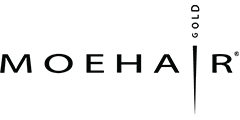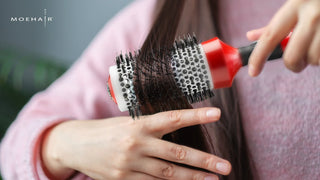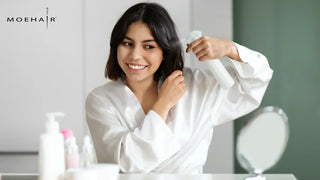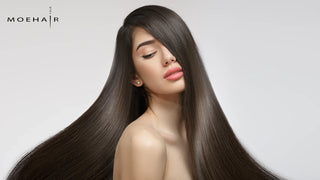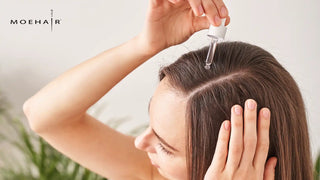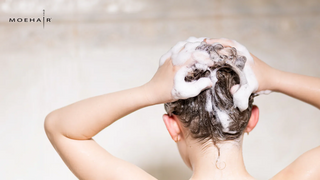 Table of contents
Table of contents
Hair brushing and detangling the knots seems simple, but is it so? It's not uncommon to vigorously brush your hair and leave strands suffocating your hair brush. Although hair brushing looks like an easy job, it's an art to do it correctly. Many people do it wrong, eventually leading to hair damage and breakage.
So, what is the right way to brush your hair? How often should you brush your hair? Do you need different hair brushing techniques to match your hair type? We have done some asking around and jotted down the blog to help you know everything about brushing hair correctly - do's and don'ts to keep your tresses healthy and wholesome.
Hair Brushing – Why is it Important?
Brushing hair, but the right way is helpful in many ways. When carefully done, it helps reduce knots, tangles, and hairfall. According to a study, it helps promote a healthy scalp by stimulating blood circulation and reducing dandruff by removing dead skin. Hair brushing is effective in shedding dead or loose hair, which helps with better hair growth. With reduced knots and tangles, brushing makes hair more manageable and less prone to breakage. Also, it is found that brushing helps remove dead skin on the scalp. Hair brushing uniformly distributes sebum from the scalp to the ends, keeping strands nourished and smooth.
How to Brush Hair According to Hair Types
Adopting the hair brushing technique is no rocket science, but it does demand gentleness. Irrespective of the hair type and texture, it is recommended to start brushing hair from the ends and gradually move upwards. This helps with easy detangling and reduces breakage. Here is how to brush hair the right way depending on hair type:
For fine and thin hair
For fine and thin hair, it is recommended to first section it for easy brushing. In longer hair, the ends are weaker and prone to breakage. Apply serum from mid-section to the ends before brushing to detangle hair. It is best to let hair dry before brushing to reduce stress on the strands. Soft boar bristle brush is the perfect choice, especially if you have a lot of fine, baby hair. Start brushing from the bottom and work your way up to get rid of the knots and tangles.
For straight and wavy hair
Brushing thick, straight, and wavy hair is best done when it is dry, as it reduces friction and prevents it from snapping. The technique remains the same, where brushing from ends gently helps detangle and gradually moves upwards towards roots. A paddle brush with nylon bristle is best recommended as it has wide-spaced pins that gently work through thicker hair types.
For curly and coily hair
As told by Angela Onuoha , Trichologist - "For curlier texture, brushing it wet is healthier." Hydrogen bonds increase hair elasticity as they temporarily break in the presence of water. Increased elasticity in curly and coily hair reduces the snapping points in wet hair, and brushing while wet reduces breakage. As curly hair is prone to tangles, use a serum or light oil to add slip before brushing. Avoid brushing hair frequently to prevent breakage. Use either a wide-tooth comb or detangling brush with soft bristles for curly and coiled hair.
How to Choose the Right Brush – As Per Hair Type and Styling Purpose
With so many types of hair brushes floating in the market, picking the right one must be more apparent. However, using the right hair brush or comb is essential, depending on the purpose and hair type. Depending on the styling need and texture of the hair, here is how to choose and invest in the brush or comb type:


- Rat Tail Comb - The name comes from its ultra-slim and long handle that helps with sectioning or parting hair. Such a comb helps with precise combing, styling, backcombing, and sectioning using the handle.
- Detangling Hairbrush - It's the perfect brush for tangles, wavy and curly hair. Also, if you prefer brushing your hair wet, it eases the knots and prevents breakage. As mentioned by Justine Marjan , celebrity stylist - "They are amazing for in the shower to work through conditioner, post-wash to gently detangle damp hair or on dry hair before styling."
- Paddle Hair Brush - These rectangular brushes have wide-spaced bristles that give better control while brushing hair. It provides smooth results without disturbing the natural wavy pattern. It usually works on all types of hair, especially straight and fine.
- Boar Bristle Brush - The iconic brushes are made of boar hair and are known for gentle, smooth brushing. The bristles help uniformly distribute the natural oil from the scalp along the hair length. In addition, it boosts scalp circulation, adds shine, and is excellent for styling hair.
- Round Brush - These are styling brushes, especially for wavy and curly hair. These brushes with bristles around the round surface help create volume, bounce, and style while blow-drying.
- Teasing Brush - These brushes are mainly used to build volume at the roots and are perfect for hair updos. Backcombing sections of hair from its roots helps in creating texture and hence gives density. However, it is meant for something other than regular use.
- Cushion Brush - These brushes have a padded bed and soft bristles, which are helpful for gentle dry brushing. These are perfect for styling and brushing fine and straight hair. However, it is necessary to clean it frequently to prevent the accumulation of microbes.
- Vented Brush - An effective hair styling brush that helps speed up the blow-drying process. The vented back helps with even heat distribution for faster styling and stimulates the scalp.
- Wide-Tooth Comb - These combs are best for detangling curly and wavy wet hair while minimizing impact and breakage. Also, it helps in the even distribution of leave-in conditioner or hair serum.
Brushing - Dry vs. Wet Hair
Your hair is fragile when wet, and vigorously rubbing or brushing leads to more hair fall. Using different hair-brushing techniques to detangle wet vs dry hair is crucial.
Brushing Wet Hair
Wet hair is laden with moisture, making it fragile and prone to breakage. Using the proper technique and type of brush is critical to minimizing damage. Experts recommend brushing curly or coiled hair when wet to reduce friction between strands. However, with proper care, you can also brush straight and wavy hair. Here are a few things to consider while brushing wet hair:

- Towel dry hair first - Instead of gliding the brush or comb through soaking wet hair, it is best to towel dry hair first. Use a microfiber towel to soak excess water and brush on damp hair.
- Add a little slip - Use a hair serum or leave-in conditioner on the hair to add slip and detangle before brushing. We recommend trying Moehair Hair Serum and Moehair Leave-In Conditioner for smooth detangling.
- Use the right brush - Not all hair brushes are meant for combing wet hair. Use either a wide-tooth comb or a detangling brush with flexible bristles to gently comb through hair length.
- Opt for the right technique - Gently detangle hair and brush from the ends. Gradually, move a few inches up and start combing. Repeat until hair is tangle-free from roots to tips.
Brushing Dry Hair
For dry hair, it is always recommended to first use a detangling product before brushing as it is more prone to tangles and knots. The dry strands rub against each other due to friction that might result in increased breakage. Here are a few things to consider while brushing dry hair:

- The technique is crucial - Start brushing from the mid-section or a few inches from the end to prevent pulling of strands. Gently remove the knots and gradually brush the hair from root to tip. This reduces stress on hair and prevents breakage.
- Apply detangling products - Before brushing dry hair, apply serum or leave-in conditioner for smooth gliding of the brush. Such products help add the much-needed slip and prevent the snapping of strands.
- Use the right brush - You can choose from different hair brushes when it comes to dry hair. A paddle brush is an excellent option for frizzy and wavy hair as it helps efficiently distribute natural oil and reduces static. If your hair is prone to tangling, opt for a detangling hair brush . Boar bristle brushes are also great for coarse hair as they eliminate static friction.
Common Brushing Mistakes to Avoid
Hair brushing techniques are simple, but doing it the right way might take some trial and error. However, to keep your hair damage-free and smooth, here are a few hair-brushing mistakes to avoid:
- Do not start brushing the hair from the root as it pulls strands and creates more tension, making it prone to breakage. Start detangling and brushing from ends and gradually move upwards towards roots.
- Use the right accessory, like a hair brush or comb, depending on hair type and styling purpose. For example, using a round brush instead of a teasing brush to build volume around roots might cause hair damage.
- Not using a detangling brush or comb to break the knots is a big mistake. Keep a detangling brush handy if your hair is prone to excessive tangles.
- Never brush hair vigorously, especially when wet, as strands are fragile and prone to breakage. Do not brush on soaking wet hair; instead, towel dry and brush damp hair.
- Avoid brushing hair without using a detangling product as it might cause pulling of hair. Use hair serum or leave-in conditioner to add slip, as it helps in easing knots.
Now that you know the right technique for hair brushing, make sure to add the right tools and products to ease the process. Be gentle with your hair, and identify your hair type and texture before using a brush. Less or too much of everything is good, so brush your hair on average to minimize damage and breakage.
Also Read: How to Use Heat Protectant Spray: A Step-by-Step Guide for Perfect Hair Protection
References:
https://typeset.io/papers/a-study-on-the-effect-of-hair-brushing-on-reducing-dandruff-2f5a89nj
https://www.thecut.com/article/how-bad-is-it-to-brush-wet-hair-really.html
https://www.instyle.com/types-of-hair-brushes-8652013
How we reviewed this article:
Our experts continually monitor the fashion and beauty space, and we update our articles when new information becomes available.
-
Current Version
-
Sept 3, 2024
Written By -
Upasana Kakati is a lifestyle writer with 7+ years of experience in writing in the beauty and haircare industry.
Edited By -
Saima Ahmed with 8+ yrs of experience, specializes in crafting engaging content focused on Hair care, lifestyle, and beauty.
